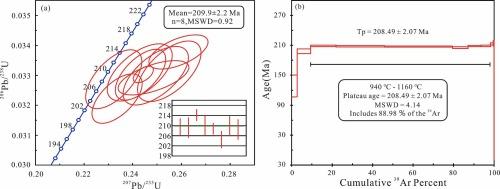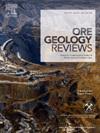评估大型花岗岩岩床的钨锰矿形成潜力:华南南岭地区天目冲钨硒矿床锆石U-Pb和麝香石Ar-Ar地质年代的启示
IF 3.2
2区 地球科学
Q1 GEOLOGY
引用次数: 0
摘要
华南南岭地区是地球上巨大的钨锡(W-Sn)成矿带之一,蕴藏着各种与高度分化的小花岗岩储量相关的 W-Sn 矿床。相比之下,大型花岗岩岩床的特点是分化程度低、侵蚀/剥蚀程度高,被认为不太适合形成钨锡矿床。然而,一些 W-Sn 矿床在空间和遗传上与大型花岗岩浴积层有关,其原因至今仍是一个谜。本研究以天目冲多金属 W-Sn 矿床为例,评估了大型花岗岩岩床的 W-Sn 成矿潜力。该矿床形成于塔山花岗岩岩体与壁岩的接触边界。它在空间上与塔山花岗岩岩床的第四侵入单元(电气石花岗岩)有关,该侵入单元含有丰富的电气石和黝帘石。电气石花岗岩的锆石U-Pb分析显示其年龄为209.9 ± 2.2 Ma,与与W-Sn矿石有关的云母Ar-Ar年龄208.5 ± 2.07 Ma一致。相似的年龄表明,电气石花岗岩的形成与钨锑矿化是共时的。测定年代的锆石显示出较高的铀、钍和铪含量以及负的欧元素异常,这意味着其起源于高分化岩浆。电气石和黝帘石的出现表明塔山电气石花岗岩富含挥发性物质(如 B 和 F),这有利于花岗岩岩浆在长期分异过程中富集 W-Sn。此外,W-锑矿成矿作用沿断层构造控制的接触带发生,这为高分化熔体的向上侵入和含 W-Sn 热液的迁移提供了有利通道。因此,表现出高度演化特征的大型花岗岩岩床晚期也显示出形成钨锑矿床的巨大潜力,尤其是在断层广泛发育的岩床边缘地带。本文章由计算机程序翻译,如有差异,请以英文原文为准。

Assessing the W-Sn ore formation potential of large granite batholiths: Insights from zircon U-Pb and muscovite Ar-Ar geochronology of the Tianmuchong W-Sn deposit in the Nanling region, South China
The Nanling region in South China represents one of the giant tungsten-tin (W-Sn) metallogenic belts on Earth, reserving a variety of W-Sn deposits associated with highly differentiated small granitic stocks. In contrast, large granite batholiths, characterized by a low degree of fractionation and a high degree of erosion/exhumation, are considered less favorable for forming W-Sn deposits. However, some W-Sn deposits are found to be related to large granite batholiths spatially and genetically, and the reasons remain a mystery. In this research, we take the Tianmuchong polymetallic W-Sn deposit as an example to assess the W-Sn ore formation potential of a large granite batholith. This deposit forms at the contact boundary between the Tashan granite batholith and wall rock. It is spatially related to the fourth intrusive unit (tourmaline granite) of the Tashan batholith, which contains abundant tourmaline and muscovite. Zircon U-Pb analysis on the tourmaline granite shows an age of 209.9 ± 2.2 Ma, in agreement with muscovite Ar-Ar age of 208.5 ± 2.07 Ma associated with W-Sn ores. The similar ages indicate that the emplacement of tourmaline granite and the W-Sn mineralization are coeval. The dated zircons display elevated U, Th, and Hf contents and negative Eu anomalies, implying an origin of highly differentiated magma. The occurrence of tourmaline and muscovite indicates that the Tashan tourmaline granite is volatile-rich (e.g., B and F), which facilitates the W-Sn enrichment under prolonged differentiation of the granitic magma. Additionally, the W-Sn ore mineralizations occur along the contact zones controlled by fault structures, which provide a favorable pathway for the upward intrusion of highly differentiated melt and the migration of W-Sn-bearing hydrothermal fluids. Therefore, the late phase of the large granite batholith that exhibits highly evolved characteristics also demonstrates a considerable potential to form W-Sn deposits, especially along the margins of the batholith with country rocks where faults are extensively developed.
求助全文
通过发布文献求助,成功后即可免费获取论文全文。
去求助
来源期刊

Ore Geology Reviews
地学-地质学
CiteScore
6.50
自引率
27.30%
发文量
546
审稿时长
22.9 weeks
期刊介绍:
Ore Geology Reviews aims to familiarize all earth scientists with recent advances in a number of interconnected disciplines related to the study of, and search for, ore deposits. The reviews range from brief to longer contributions, but the journal preferentially publishes manuscripts that fill the niche between the commonly shorter journal articles and the comprehensive book coverages, and thus has a special appeal to many authors and readers.
 求助内容:
求助内容: 应助结果提醒方式:
应助结果提醒方式:


